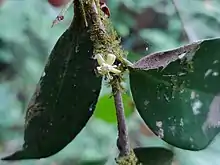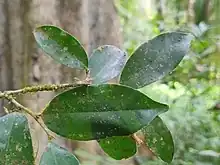| Drypetes wightii | |
|---|---|
 | |
| Scientific classification | |
| Kingdom: | Plantae |
| Clade: | Tracheophytes |
| Clade: | Angiosperms |
| Clade: | Eudicots |
| Clade: | Rosids |
| Order: | Malpighiales |
| Family: | Putranjivaceae |
| Genus: | Drypetes |
| Species: | D. wightii |
| Binomial name | |
| Drypetes wightii (Hook.f.) Pax & K.Hoffm. | |
| Synonyms[2] | |
| |
Drypetes wightii is an evergreen tree species endemic to the Western Ghats, India.[3] The species is considered Vulnerable under the IUCN Redlist of Threatened Species.[1]
Description

The species occurs as small trees up to 12 m tall. The bark and trunk appear whitish. The trees have a characteristic horizontal branches, with cylindrical branchlets. Branchlets and leaves lack hairs. The leaves are simple, alternate, and distichous, with short petioles about 0.2 - 0.6 cm long. The leaf blade is sub-coriaceous, about 4-9 cm long by 1.5 to 3.5 cm wide, dark green, drying pale greenish to brown. The shape of the leaves is elliptic with a slight asymmetric base and an acuminate apex. The margin is entire. The leaves have a midrib that is flat above. Leaves have 6-9 pairs of secondary nerves.[4] The flowers are unisexual, with male flowers in axillary clusters from pedicels about 3-5 mm long, puberulous and 4 to 5 tepals about 3 x 2-2.5 mm in size, 6-10 stamens that are about 1-1.5 mm long. The stamen filaments are free, with oblong anthers.[5] The female flowers are also axillary, but solitary, with pedicels 4-5 mm long, puberulous and 4-5 tepals about 3-4 × 2.5-3.5 mm in size; disc annular and reniform stigma. The ovary is about 2 x 1 mm, ellipsoid and with a single locule with two ovules, sparsely puberulous to glabrous. The fruit is a drupe, ovoid to ellipsoid in shape, about 1.7-2 cm long by 1.5 cm wide, smooth and hair-less, with a pedicel about 10-12 mm long and holding a single seed.[4][5]
Range
The species occurs in the Western Ghats mountains in the states of Tamil Nadu and Kerala from Wynaad and the Nilgiris in the North to the Anamalai Hills. It occurs between 900 and 1500 m.[4][6]
Habitat
The trees occur in mid-elevation (900 to 1500 m) tropical wet evergreen forests of the Western Ghats.
Ecology
The species is considered rare and is found in the understorey of taller trees.[4] It has been reported to occur at a density of 6 to 24 stems per hectare in tropical wet evergreen forests in different locations.[7][8][9]
Etymology
The specific epithet derives from Robert Wight, whom the species is named for. In Malayalam, the species is called vellakasavu.[5]
References
- 1 2 World Conservation Monitoring Centre (1998). "Drypetes wightii". IUCN Red List of Threatened Species. IUCN. 1998: e.T38765A10143619. doi:10.2305/IUCN.UK.1998.RLTS.T38765A10143619.en.
- ↑ "Drypetes wightii". Plants of the World Online. Royal Botanic Gardens, Kew. Retrieved 10 September 2022.
- ↑ "Drypetes wightii". iNaturalist. Retrieved 2022-09-07.
- 1 2 3 4 "Drypetes wightii - EUPHORBIACEAE". www.biotik.org. Retrieved 2022-09-07.
- 1 2 3 "Drypetes wightii (EUPHORBIACEAE) : Vellakasavu". keralaplants.in. Retrieved 2022-09-07.
- ↑ "Drypetes wightii (Hook.f.) Pax & K.Hoffm. | Species". India Biodiversity Portal. Retrieved 2022-09-07.
- ↑ Kunhikannan, C.; Venkatasubramanian, N.; Sivalingam, R.; Pramod Kumar, N.; Thomas, Salvy; Thampan, Sibin (2011). "Diversity of woody species in the Medicinal Plant Conservation Area (MPCA) of Silent Valley National Park, Kerala". Biodiversity. 12 (2): 97–107. doi:10.1080/14888386.2011.602930. ISSN 1488-8386. S2CID 85125680.
- ↑ Chandrashekara, U. M.; Ramakrishnan, P. S. (1994). "Vegetation and Gap Dynamics of a Tropical Wet Evergreen Forest in the Western Ghats of Kerala, India". Journal of Tropical Ecology. 10 (3): 337–354. doi:10.1017/S0266467400008014. ISSN 0266-4674. JSTOR 2560318. S2CID 83780066.
- ↑ Muthuramkumar, S.; Ayyappan, N.; Parthasarathy, N.; Mudappa, Divya; Raman, T. R. Shankar; Selwyn, M. Arthur; Pragasan, L. Arul (2006). "Plant Community Structure in Tropical Rain Forest Fragments of the Western Ghats, India 1: Plant Diversity in Rain Forest Fragments". Biotropica. 38 (2): 143–160. doi:10.1111/j.1744-7429.2006.00118.x. S2CID 54011462.
